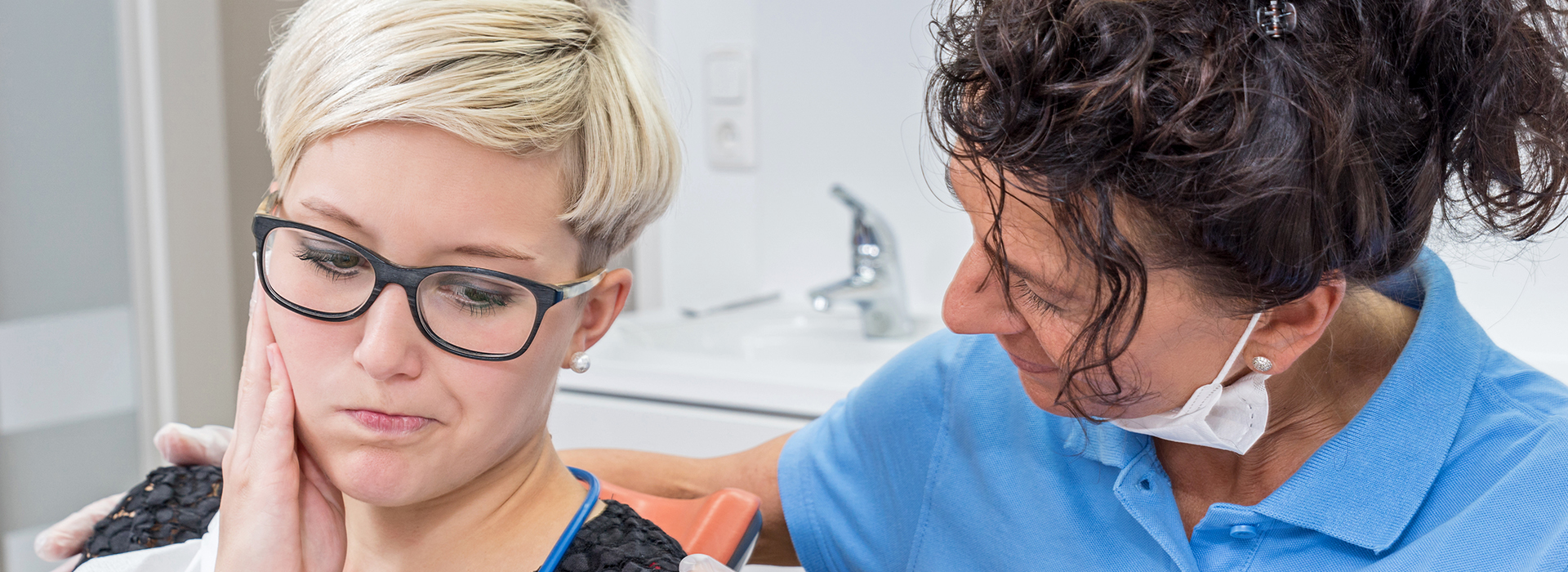
Dental problems can escalate quickly. If you experience severe pain, uncontrolled bleeding, swelling that affects breathing or swallowing, or a tooth that has been knocked out, these are signs that you should seek professional help right away. Prompt attention can reduce pain, limit the risk of infection, and improve the chances of saving a damaged tooth.
Not every urgent situation looks dramatic. Persistent, worsening toothaches, sudden sensitivity to cold or hot that won’t subside, or a lump or sore in the mouth that appears suddenly should also be evaluated without delay. Early assessment helps determine whether immediate treatment or a planned intervention is most appropriate.
Our practice takes emergency concerns seriously and follows a clear triage approach to make sure patients get the right level of care quickly. We prioritize stabilizing the issue, relieving pain, and preventing further damage while communicating the next steps in straightforward terms so you know what to expect.
When you arrive for an emergency appointment, the initial focus is on a rapid, focused evaluation. A clinician will review your symptoms, medical history, and any recent events that led to the problem. This quick assessment allows the team to identify immediate risks and create a short-term plan to stabilize your condition.
Diagnosis commonly involves a visual exam and targeted imaging when needed. Modern digital X-rays and other imaging tools let clinicians see beneath the surface to identify fractures, abscesses, and other problems that aren’t visible to the naked eye. These tools help guide efficient, conservative care tailored to your situation.
Treatment during the first visit aims to control pain and infection, protect exposed tissues, and restore basic function. That might mean placing a temporary crown or filling, suturing a soft-tissue injury, prescribing medication to manage infection or pain, or performing a root canal or extraction when necessary. The goal is always to preserve oral health and comfort while planning definitive care.
Knowing a few practical steps to take before you get to a dental office can make a significant difference. For a knocked-out permanent tooth, carefully pick it up by the crown (avoid touching the root), rinse it gently if dirty, and try to reinsert it into the socket if possible. If reinsertion isn’t feasible, keep the tooth moist in milk or a tooth-preservation solution and get to a dentist right away.
For a toothache, rinse your mouth with warm salt water and floss around the affected tooth to remove trapped debris. Over-the-counter pain relievers can help manage symptoms temporarily, but avoid placing aspirin directly on the gum or tooth. For swelling, applying a cold pack externally for short intervals can reduce inflammation while you arrange professional care.
If you experience a laceration or a soft-tissue injury, apply gentle pressure with clean gauze to control bleeding and seek prompt evaluation to determine whether sutures or other interventions are needed. In all cases of trauma, if you suspect a jaw fracture, difficulty breathing, or other systemic symptoms, seek emergency medical attention immediately.
Tooth fractures and chips: Minor chips can often be smoothed or bonded with tooth-colored materials to restore appearance and function. Larger fractures that expose the inner tooth tissues may require a crown or root canal to prevent infection and preserve the tooth structure.
Severe toothaches and abscesses: Pain from deep decay or an abscess is typically addressed by controlling infection and removing the source of irritation. That may involve drainage, root canal therapy to save the tooth, or extraction if the tooth is not restorable. Antibiotics and pain management are used as needed while definitive treatment is planned.
Lost or damaged restorations: A dislodged crown or filling can expose the underlying tooth and cause sensitivity or pain. In many cases, we can re-cement or place a new restoration quickly to protect the tooth and restore function. For dentures and prosthetics, adjustments can often be made to improve fit and comfort until a permanent repair is arranged.
Once immediate concerns are managed, the focus shifts to long-term recovery and protecting your oral health. That may include definitive restorations, replacement of missing teeth with implants or bridges, or periodontal care to address gum-related problems that contribute to recurring issues. A clear, step-by-step treatment plan helps patients understand timing, expected outcomes, and follow-up needs.
Preventive strategies play an important role in reducing future emergencies. Routine exams, timely restorations, protective mouthguards for sports, and patient education on injury prevention and oral hygiene all reduce the likelihood of urgent problems. People with complex dental histories may benefit from a personalized maintenance schedule to catch issues early.
Our team uses modern diagnostic technology and evidence-based techniques to deliver conservative, effective care. With a focus on comfort and clear communication, we aim to restore oral health while minimizing disruptions to your daily life. If you need urgent dental attention, the office of Dr. Aaron Tropmann & Dr. Gary Oyster is prepared to evaluate your situation and guide you toward the right solution.
In summary, dental emergencies require timely, knowledgeable care to relieve pain and protect long-term oral health. If you or a family member is facing an urgent dental issue, contact us to arrange an evaluation and begin treatment. We’re here to help and ready to answer your questions about emergency care.

Signs that require immediate attention include severe, uncontrolled pain, heavy bleeding, swelling that interferes with breathing or swallowing, and a tooth that has been completely knocked out. Persistent or worsening toothaches, sudden sensitivity that does not subside, and new lumps or sores in the mouth should also be evaluated promptly. Early assessment reduces the risk of infection and increases the chances of preserving the affected tooth.
If you are unsure whether a situation is urgent, call the office of Dr. Aaron Tropmann & Dr. Gary Oyster or your dental provider for guidance on next steps. A quick phone triage can help determine if you need to come in right away or can be scheduled for a near-term appointment. When in doubt and symptoms are severe or accompanied by systemic signs like fever or difficulty breathing, seek emergency medical care.
Handle the tooth by the crown and avoid touching the root to preserve cells that support reattachment. Rinse the tooth gently if it is dirty but do not scrub it; try to reinsert it into the socket and hold it in place, or keep it moist by placing it in milk or a tooth-preservation solution if reinsertion is not possible.
Get to a dentist as soon as possible because reimplantation success drops quickly with time. Bring the tooth with you and be prepared to describe how the injury occurred and any steps you already took, as prompt professional attention gives the best chance of saving the tooth.
Initial emergency care focuses on controlling pain and infection while diagnosing the underlying cause through a clinical exam and targeted imaging. Treatment may include drainage of an abscess, root canal therapy to remove infected tissue, or extraction if the tooth cannot be saved.
Antibiotics and prescription pain medication can be provided when there is evidence of spreading infection or significant discomfort, and a clear plan for definitive care will be outlined. Follow-up treatment is often necessary to restore full function and prevent recurrence, and your dental team will explain the options and timing for longer-term restoration.
An emergency visit begins with a focused medical and dental history and a rapid clinical assessment to identify immediate risks and priorities. Diagnostic tools such as digital X-rays are used when needed to evaluate fractures, root problems, or abscesses that are not visible on the surface.
Treatment during the visit is aimed at stabilizing the problem—controlling pain, addressing infection, protecting exposed structures, and restoring basic function when feasible. The team will discuss the findings, explain short-term measures taken, and outline any required follow-up or definitive procedures in plain terms.
In many cases a dislodged crown or filling can be temporarily re-cemented or replaced to protect the tooth and relieve sensitivity. Quick repairs are intended to seal exposed dentin and prevent further damage while a permanent restoration is planned.
If the underlying tooth is fractured or infected, additional treatment such as a crown, root canal, or extraction may be necessary to ensure long-term success. Your dentist will evaluate the condition, explain why a temporary fix was chosen if appropriate, and provide a timeline for definitive care.
For cuts and lacerations inside the mouth, apply gentle pressure with clean gauze to control bleeding and rinse with saline or water to clear debris. Cold packs applied externally can reduce swelling and pain for short intervals, and over-the-counter analgesics can be used according to the product instructions to manage discomfort.
If bleeding is heavy, a jaw appears misaligned, or there are signs of head injury, seek emergency medical attention immediately rather than only dental care. Your dentist can manage many oral lacerations and will determine if sutures or further medical evaluation are required.
You should go to the emergency room if you experience difficulty breathing, uncontrolled bleeding, signs of a severe allergic reaction, or loss of consciousness following facial trauma. The emergency room is also appropriate when a jaw fracture is suspected or when dental injury is accompanied by head trauma that requires immediate medical evaluation.
For severe dental pain, swelling that threatens the airway, or systemic symptoms like high fever, the ER can provide urgent stabilization before referral to a dental specialist. Your dentist can advise when to visit the ER during after-hours calls or triage conversations.
Treatment for pediatric dental emergencies follows the same priorities of airway safety, pain control, and infection management, with additional attention to a child’s comfort and emotional needs. Techniques are adapted for a child’s size and behavior, and efforts are made to preserve primary teeth when appropriate to maintain space and function.
Parents should bring any avulsed teeth, note the timing and details of the injury, and seek care promptly; success rates for tooth reimplantation are time-sensitive. The practice will explain treatment options and expected outcomes, and provide guidance on at-home care and monitoring during recovery.
After immediate concerns are addressed, your dentist will provide a clear plan for follow-up that may include definitive restorations, additional endodontic work, or periodontal treatment depending on the issue. Instructions typically cover oral hygiene, activity restrictions, medication use, and signs that warrant an earlier return to the office.
Recovery appointments allow monitoring of healing, replacement of temporary restorations with permanent solutions, and prevention planning to reduce the chance of recurrence. The office of Dr. Aaron Tropmann & Dr. Gary Oyster will work with you to schedule and coordinate any necessary specialist referrals or restorative care.
Regular dental exams, timely treatment of small problems, and protective measures such as custom mouthguards for sports are effective ways to lower emergency risk. Good daily oral hygiene and prompt attention to persistent symptoms like sensitivity or loose restorations help catch issues before they escalate.
Discussing your dental history and any high-risk activities with your dentist allows for a personalized prevention plan that may include periodic monitoring, restorative upgrades, or behavior changes. Consistent care and early intervention are the best strategies to preserve oral health and avoid urgent situations.

Ready to book your next appointment or have a question for our team? We're here to help.
Connecting with our team is simple! Our friendly staff is here to help with appointment scheduling, answer any questions about your treatment options, and address any concerns you may have. Whether you prefer to give us a call, send an email, or fill out our convenient online contact form, we’re ready to assist you. Take the first step toward a healthier, brighter smile – reach out to us today and experience the difference compassionate, personalized dental care can make.